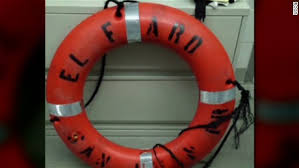
According to the Associated Press, Searchers have located what is believed to be wreckage of El Faro
The AP reports that on November 1, 2015 8:30 AM, Investigators will use a deep ocean vehicle to help confirm whether wreckage that searchers found in 15,000 feet of water east of the Bahamas is the cargo ship El Faro that vanished during Hurricane Joaquin.
The U.S. National Transportation Safety Board said in a statement from Washington that a remotely operated vehicle will be sent deep below the ocean surface in an operation that could begin as early as Sunday. The El Faro went missing Oct. 1 with 33 crewmembers on heaving seas.
Authorities also said late Saturday that they want to survey the wreckage and locate a voyage data recorder — or the ship's "black box" — that could yield clues as to what happened.
An NTSB statement said a specially equipped Navy vessel located wreckage Saturday afternoon in the area of the ship's last known position. It said the wreckage is "consistent with a 790-foot cargo ship, which from sonar images appears to be in an upright position and in one piece."
The 790-foot El Faro was reported missing east of the Bahamas, according to the Coast Guard.
Saturday's announcement by the NTSB, which is investigating the disappearance, came after a ship it contracted for the search from the Navy, the USNS Apache, had spent days combing those waters.
"To confirm the finding, specialists on Apache will use CURV 21, a deep ocean remotely operated vehicle to survey and confirm the identity of the wreckage. This survey could begin as early as November 1," said the statement emailed by Peter Knudson from the NTSB's public affairs office in Washington.
The El Faro's captain had called in before the vessel disappeared saying the ship had lost its engine power during its voyage from Jacksonville, Florida, to San Juan, Puerto Rico. The captain, Michael Davidson, said the ship was listing, and taking on water.